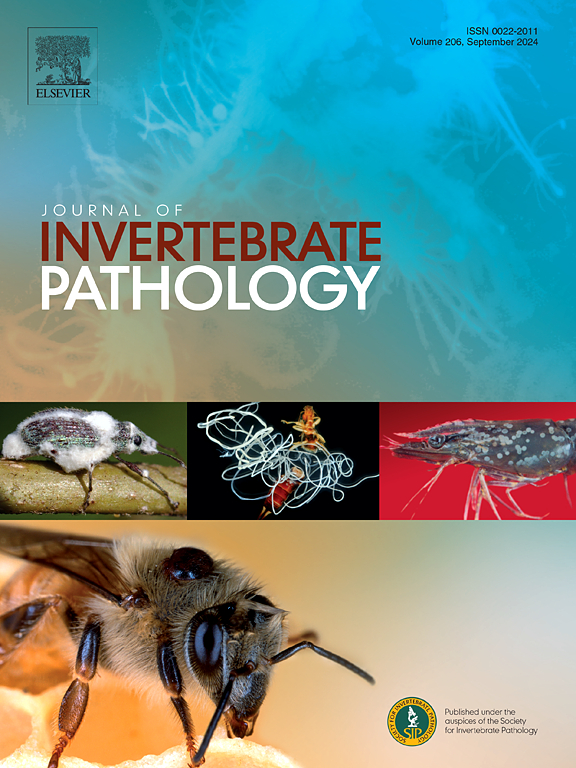An in-depth study of the growth inhibition of Vibrio parahaemolyticus by Surfactin and its effects on cell membranes, ROS levels and gene transcription
IF 2.4
3区 生物学
Q1 ZOOLOGY
引用次数: 0
Abstract
Acute hepatopancreatic necrosis disease (AHPND) caused by Vibrio parahaemolyticus (VpAHPND) poses a significant challenge to the shrimp farming industry. Although lipopeptides produced by Bacillus subtilis have been shown to exert strong inhibitory effects against Vibrio parahaemolyticus, the underlying mechanisms remain largely unexplored. This study reveals that the lipopeptide surfactin, produced by Bacillus subtilis, significantly inhibits the VpAHPND strain JSHY-1669 through multiple mechanisms. Using antagonistic assays and transcriptomic analysis, this paper investigates the molecular mechanisms of surfactin’s inhibitory action on VpAHPND strain JSHY-1669. The minimum inhibitory concentration (MIC) of surfactin against JSHY-1669 was determined to be 0.125 mg/mL, with a cumulative inhibitory effect. Exposure to surfactin caused significant structural damage to the bacterial cells, markedly inhibiting their growth and virulence gene expression. Transcriptomic analysis identified 64 genes with significant differential expression, including upregulation of genes involved in key metabolic pathways such as carbohydrate transport, and downregulation of non-essential pathways like amino acid and sulfur metabolism. Surfactin affects JSHY-1669 by disrupting key physiological processes. Specifically, it increases cell membrane depolarization, reactive oxygen species (ROS) production, and malondialdehyde (MDA) levels. These changes collectively lead to the loss of membrane integrity, which ultimately inhibits bacterial growth. Additionally, the study found downregulation of slyA, a key regulatory factor related to DNA-binding transcription, virulence regulation, and carbohydrate metabolism. Surfactin may expand its inhibitory range by affecting the slyA regulatory network, providing a basis for surfactin’s broader antibacterial targets. These findings elucidate the inhibitory mechanisms of surfactin on VpAHPND strain JSHY-1669, laying a foundation for its potential applications.

深入研究表面素对副溶血性弧菌生长的抑制作用及其对细胞膜、活性氧水平和基因转录的影响
副溶血性弧菌(VpAHPND)引起的急性肝胰腺坏死病(AHPND)是对虾养殖业面临的重大挑战。虽然枯草芽孢杆菌产生的脂肽已被证明对副溶血性弧菌具有很强的抑制作用,但其潜在的机制仍未被充分探索。本研究揭示枯草芽孢杆菌产生的脂肽表面素通过多种机制显著抑制VpAHPND菌株JSHY-1669。通过拮抗实验和转录组学分析,探讨了表面素抑制VpAHPND菌株JSHY-1669的分子机制。表面素对jsh -1669的最小抑制浓度(MIC)为0.125 mg/mL,具有累积抑制作用。暴露于表面素对细菌细胞造成明显的结构损伤,显著抑制其生长和毒力基因的表达。转录组学分析鉴定出64个具有显著差异表达的基因,包括参与碳水化合物运输等关键代谢途径的基因上调,以及氨基酸和硫代谢等非必需途径的基因下调。表面素通过破坏关键生理过程影响jsh -1669。具体来说,它增加了细胞膜去极化、活性氧(ROS)的产生和丙二醛(MDA)的水平。这些变化共同导致膜完整性的丧失,最终抑制细菌生长。此外,该研究还发现slyA下调,slyA是与dna结合转录、毒力调节和碳水化合物代谢相关的关键调节因子。Surfactin可能通过影响slyA调控网络来扩大其抑制范围,为其更广泛的抗菌靶点提供了基础。这些发现阐明了表面素对VpAHPND菌株jsh -1669的抑制机制,为其潜在的应用奠定了基础。
本文章由计算机程序翻译,如有差异,请以英文原文为准。
求助全文
约1分钟内获得全文
求助全文
来源期刊
CiteScore
6.10
自引率
5.90%
发文量
94
审稿时长
1 months
期刊介绍:
The Journal of Invertebrate Pathology presents original research articles and notes on the induction and pathogenesis of diseases of invertebrates, including the suppression of diseases in beneficial species, and the use of diseases in controlling undesirable species. In addition, the journal publishes the results of physiological, morphological, genetic, immunological and ecological studies as related to the etiologic agents of diseases of invertebrates.
The Journal of Invertebrate Pathology is the adopted journal of the Society for Invertebrate Pathology, and is available to SIP members at a special reduced price.

 求助内容:
求助内容: 应助结果提醒方式:
应助结果提醒方式:


